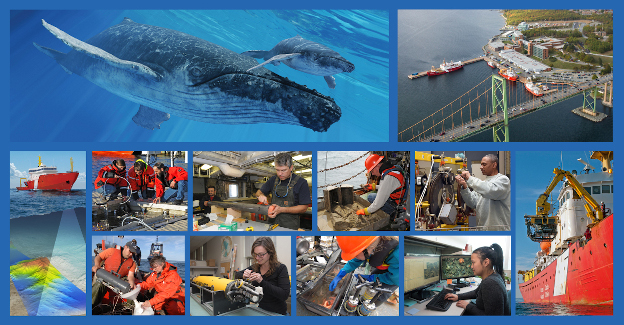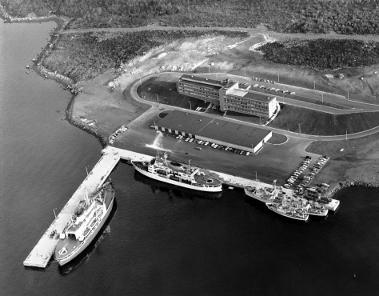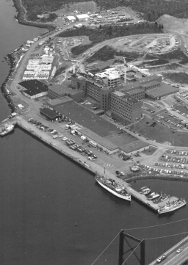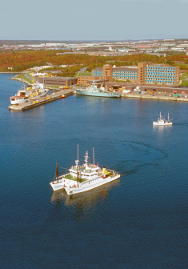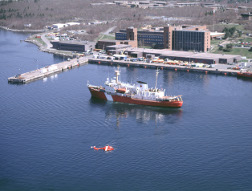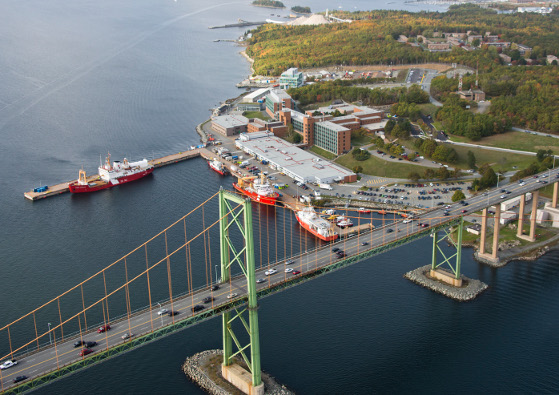Bedford Institute of Oceanography
About BIO
BIO is a modern oceanographic research facility, established in 1962 by the Federal Government of Canada (the former Department of Mines and Technical Surveys, now Natural Resources Canada) and is located on the shores of the Bedford Basin in Dartmouth, Nova Scotia. Over the last 50 years it has grown to become Canada's largest centre for ocean research. The Institute performs targeted research, mandated by the Canadian government, to provide 'peer' reviewed advice and support to government decision making on a broad range of ocean issues, including sovereignty, safety and security, environmental protection, the health of the oceans, safe and accessible waterways, the sustainable use of natural resources (fisheries, minerals, oil & gas) and the integrated management large ocean management areas.
Bordered by three oceans, Canada has a 240,000-km coastline, the longest of any country in the world. Its continental shelf represents an area about 40% the size of the Canadian landmass. Against this background, Canada must collect information about all aspects of its ocean resources; this information is vital for land-use and coastal planning, ocean management and reducing risk from natural and anthropogenic hazards. In and under the oceans, enormous quantities of natural resources reside in the water column or lie buried in the bedrock; these include stocks of fish, shellfish and marine plants, oil and natural gas and mineral resources. This can mean economic sustainability for generations of Canadians and is the basis of our collective efforts to submit a claim under article 76 of the United Nations Convention on the Law of the Sea (UNCLOS). Our UNCLOS work will form the scientific basis for a claim for the seabed rights over an area beyond the 200 miles of our current exclusive economic zone.
Oceanography, by nature, is a multidisciplinary research field, involving geological, physical, chemical and biological research disciplines. To solve problems related to the oceans, BIO houses over 600 researchers, engineers, technicians, natural resource and environmental managers, and support staff from a variety of different disciplines. Currently, four federal departments are located at BIO: Fisheries and Oceans Canada (DFO), Natural Resources Canada (NRCan), Environment Canada (EC), and the Department of National Defence (DND). The facilities are all managed by Public Works and Government Services Canada (PWGSC).
DFO has a number of different Branches working at BIO. The largest is the Science Branch with the Regional Director of Science also being the Director of BIO. There are five Science Divisions at BIO: the Canadian Hydrographic Service (CHS); Ocean Sciences; Population Ecology; Ecosystem Research; and Strategic Planning, Advisory Activities and Outreach. The Oceans, Habitat and Species at Risk Branch has all four of its divisions located at BIO. The Informatics Branch provides all appropriate computing services as well as being a national centre of long term data storage and handling. The Fisheries and Aquaculture Management Branch is represented at BIO with the Regional Aquaculture Coordination Office. The Canadian Coast Guard (CCG) has a technical services section at BIO which provides a broad base of support to our fleet of ocean and coastal vessels. The CCG will soon have a much larger presence at BIO with the relocation of the CCG Dartmouth Base from its present waterfront location on Parker Street to BIO.
NRCan is represented by the Geological Survey of Canada (Atlantic). It has become Canada's principal marine geo-science facility and its scientific research expertise focuses on marine and petroleum geology, geophysics, geochemistry and geo-technology. GSC Atlantic is the source of integrated knowledge and advice on Canada's coastal and offshore underwater landmass and is also leading the national program for UNCLOS.
DND supports its ocean surveillance and security activities through the Maritime Forces Atlantic's Route Survey Office located at BIO. In co-operation with CHS and GSC Atlantic, multi-beam surveys of areas of the sea floor of specific interest to DND are conducted, analyzed, mapped and charted.
The Marine Water Quality Monitoring Unit of Environment Canada conducts sanitary and water quality surveys and analyzes the samples at the microbiology laboratory at BIO in support of the Canadian Shellfish Sanitation Program.
PWGSC has a dedicated team of facility service specialists that keep the entire BIO Campus operating effectively and efficiently.
A Brief History of BIO
Following World War II, Canada recognised that it needed dedicated multi-disciplinary oceanographic research institutes and vessels to address issues such as sovereignty, defence, environmental protection and fisheries. The St. Andrews Biological Station was the principle marine fisheries research facility in the Maritimes at that time. Dr. W. E. van Steenburgh, the then Director-General of Scientific Services of the Department of Mines and Technical Surveys, was instrumental in promoting the concept of an oceanographic institute on the Bedford Basin. He and his team had the vision that multi-disciplinary research teams with dedicated vessel and laboratory support were required in order to meet the future knowledge needs of ocean management in the emerging global economy. As a consequence of his efforts, the construction of both the Bedford Institute of Oceanography (BIO) and the expedition class vessel, the Hudson, were celebrated in 1962. To this day, the original wing of BIO is named in Dr. Van Steenburgh's honour. Dalhousie University honoured Dr. Van Steenburgh in October 1962 for his key role in providing the essential federal government infrastructure support for oceanographic research in Canada.
With state-of-the-art facilities and seagoing capability, BIO has grown considerably since 1962, becoming one of the premier world-class multi-disciplinary research institutes in oceanography. What makes BIO unique is its multidisciplinary nature. Oceanography is, by this nature, a multi-disciplinary research field, involving hydrography, geological, physical, chemical, biological and fisheries research disciplines. Indeed, the success of the major research institutes of oceanography around the world is that specialists from the different disciplines within oceanography work in proximity on complex and challenging research problems. This has resulted in fundamental and revolutionary increases in our understanding of the global oceans and sea floor during the past several decades. BIO is one example of a research facility that has contributed to this exciting increase in explanatory power. A key feature of its research success has been the melding of diverse research disciplines within a single facility. Hydrographers, geologists, physicists, chemists, biologists and technical specialists work side by side in teams on challenging research questions. BIO houses scientists and technical staff of four federal departments (DFO, NRCan, DND and EC) and has established partnerships with universities, industry, First Nations and non-governmental organizations.
Proof that this approach works is seen in its history. Since its inception, BIO has been heavily involved in numerous projects and studies at the national and global scale on the world's ocean circulation systems and how these interact with climate change. At the same time, it has undertaken comprehensive studies of the marine geology of Atlantic Canada, providing critical support to oil and gas exploration efforts in the 1980's and more recently. In the 1970's, the Institute considerably expanded its study of the ocean ecosystems and their resources, a trend that has continued to this day. And the need for multidisciplinary ocean research continues.
In 1997, Canada passed an internationally unique set of legislation. Termed the Oceans Act, it outlines a new approach to ocean resource usage, based upon the principles of wise ecosystem-based management. Due to our increasing use of the oceans (oil and gas exploration, undersea cables, marine transportation, aquaculture, eco-tourism, sewage and industrial waste disposal, recreational activities and commercial fishing), Canada needs an enhanced research capacity to provide scientific advice on management issues. The preamble of the 1997 Oceans Act captures the challenges of the coming decades. The Act states that Canada must develop and implement the management of its marine ecosystems, following three interlocking principles (integrated management using the precautionary approach to ensure sustainable development). The Act is fully consistent with Canada's international obligations under, for example, the Convention of Biological Diversity, the Kyoto Climate Change Convention, and the Food and Agriculture Organisation Code of Conduct for Responsible Fishing. Canada is moving towards a new paradigm for the integrated management of its ocean activities, within which marine ecosystem objectives will be more explicitly defined to ensure sustainable development for future generations. This shift in management perspective by Canada is consistent with the global awareness that our oceans need enhanced protection from human influences.
In addition to the direct impacts caused by ocean industries and disposal of contaminants, "greenhouse gases" are contributing to climate variability. Global ocean circulation is changing, sea-level is rising, and air-sea interactions are modifying weather and climate patterns. The oceans are a key component of climate variability, and multi-disciplinary oceanographic research will contribute to understanding and predicting the nature of the change.
The agenda of the Government of Canada places a high priority on enhanced citizen engagement. BIO is moving in this direction with a higher priority being given to "outreach" with the public. Indeed, the Institute is a major focal point in Atlantic Canada for stewardship of the oceans. The needs for federal government infrastructure support for multi-disciplinary oceans research in Canada are equally, if not more, important now as they were under Van Steenburgh's leadership in the 1960's. Many of the original buildings are being renovated to meet the energy conservation needs of a globally informed society.
- Date modified:
